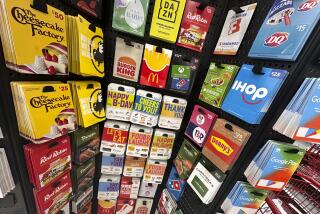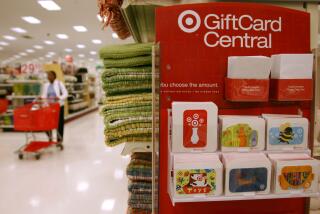Big Day for Cards : Valentines Are Still 2 Sweet 2 Be 4 Gotten
- Share via
Lisa DiMarzio and her younger sister sorted through racks of unusual Valentine’s Day greeting cards at a Card Factory store in West Los Angeles.
“I used to be real big on teddy bears,” DiMarzio said.
“I think they’re baby-fied,” volunteered her sister Andrea Capoziello.
Mostly they picked up cards with lots of hearts on them. Both said they already had stacks of cards at home that had struck their fancy on previous visits, but they were back to find just the right sentiment for the right friends and relatives.
For her husband, an architect, DiMarzio ended up selecting a card of a floor plan with a heart in one room. But Capoziello couldn’t settle on one card to send her boyfriend.
“I have two I’m sending to the same person--one’s really mushy and one’s really funny,” she said before buying five cards and heading for yet another card store to buy more traditional cards for relatives. Valentine’s Day “is my favorite holiday throughout the year, always.”
Americans will exchange nearly a billion cards by Sunday, half of them by hand, according to the Washington-based, 112-member Greeting Card Assn. Only Christmas, with 2.2 billion cards, provides card makers with a greater annual bonanza than February’s $280-million love fest. Popular cards this year range from the romantic to the risque and take longer to design and distribute than most buyers realize.
Less Sappy
Teachers are the leading recipients of Valentine cards, followed by children, mothers, wives and then sweethearts, Greeting Card Assn. spokeswoman Patti Brickman said. Schoolchildren buy small, cheap cards by the box and exchange an average of 22 cards apiece each year, she added. “That goes along with teachers receiving a lot of them.”
Among cards bought by adults, the trends are toward more hearts, roses and toy teddy bears, more red, mauve and orange backgrounds (“the deco attire”), and more succinct messages, Brickman said. “Verses are a lot shorter, a lot less sappy, more direct.”
Humorous valentines are also growing in popularity, though they’re not new. So-called “vinegar valentines” and “penny dreadfuls” were widely sold in the 19th Century. A card sold this year reads, “Valentine, I love you in spite of your faults . . . and believe me that’s love!” Another card shows a young woman in a red bikini, clutching a beer labeled “Love Brew.” Inside the card: “This bod’s for you.”
Cards depicting scantily clad men and women have only been common in family card stores for the last five years, though they have circulated in adult bookstores and other specialty stores “forever,” said R. Chris Martin, a professor of psychology at the University of Missouri and a consultant to Hallmark Cards.
Some of this year’s commercially sold cards may be treasured for years, while others are crumpled immediately and thrown straight in the trash can.
But all these cards take months to design, produce and distribute. At Cleveland-based American Greetings, the nation’s second-largest card maker after Hallmark Cards, 500 artists, writers and editors work to develop cards that may take as long as 18 months to reach the consumer, spokeswoman Jody Roberts said. About 90% of the designs are changed each year, although some of the new cards contain one-liners or artwork from best sellers of past years, Assistant Product Manager Leslie Croy said.
Lengthy Production Process
Creative Papers Greeting Cards--a division of Norwalk, Conn.-based C. R. Gibson--starts making Valentine art assignments to free-lance writers and artists as early as March, Product Manager John Carroll said. Finished copy is not ready until May, June, or even early July. “You assign, make revisions, and it goes back and forth a few times,” he said.
Typesetting and other preparations for printing take a week to a month, and the cards are printed in July and August. Samples and catalogues go out in late August and September, and orders from stores are taken through late January, Carroll said.
Creative Papers starts shipping Valentine cards on Dec. 1 to the warehouses of major chains. But small, independent gift shops with little storage space often ask not to receive their shipments until after Christmas, Carroll said. Greeting cards for Easter, Mother’s Day, Father’s Day and graduation are drawn and printed at the same time as Valentine cards but are not shipped until February.
A wholesale carton of Creative Papers’ cards holds a dozen copies each of 16 different designs, for a total of 192 cards. The cards sell in stores for 95 cents apiece; a carton is worth $182.40 at retail. The company charges retailers $91.20 a carton, Carroll said. “Their markup is 100%.”
Most larger card companies allow retailers to return or destroy unsold cards and receive credit or special discounts on future purchases, Carroll said. “It’s almost never cash back. It’s credit against future purchases.”
Hallmark Cards, headquartered in Kansas City, Mo., does not allow stores to return cards, spokeswoman Barbara Miller said. “(It’s) for the retailer to order to meet his needs.”
Children in school usually make Valentine cards in the shape of hearts. Yet commercially made Valentine’s day cards are almost invariably rectangular. The reason, Carroll explained, is not a conspiracy among card makers or even difficulties in production and packaging. Rather, the problem lies in how store racks display cards.
“If you stand them on a point, they’re going to fall over,” he said.


